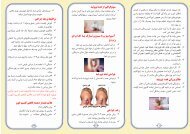Quality Assurance In Blood Bank
Quality Assurance In Blood Bank
Quality Assurance In Blood Bank
You also want an ePaper? Increase the reach of your titles
YUMPU automatically turns print PDFs into web optimized ePapers that Google loves.
<strong>Quality</strong> Control<strong>Quality</strong> AssurenceofImmunohematology ofReagentsSpeaker Prof. A.PourazarIsfahan IRAN
Continue• <strong>In</strong>spection should be carried out once every year tocheck.• External <strong>Quality</strong> Assessment (EQA) program onregional and / or national level must be exercised.• <strong>In</strong>ternal <strong>Quality</strong> Control (IQC) by continuousmonitoring all aspects of blood banking should beset.• Procedural manual and Standard Operating Precedure(SOP)
Reagent <strong>Quality</strong> Control• On arrival, for titer and avidity of anti-sera• Daily basis : Anti-A, A, Anti-B and Anti-AB ABwith know A/B red cells respectively forreactivity.• Anti – D with know Rh.D positive red cellfor reactivity and Rh.D negative red cellsspecificity
Continue• Anti-Human Globulin reagent with Anti-Dcoated red cells (Check – Cells) for reactivityand with uncoated red cells for specificity.• Other reagent : like enzymes, albumin,enhancement in reactivity of IgG anti-D• And use of enzyme of reduction in reactivityof anti-Duffy or antibodies to MNSs bloodgroup and so on …
Standard titer and avidity of ABOreagentAntibody titer with cells titer avidity secondAnti-A A A1 256 10Anti-A A A2 128 20Anti-A A A2B 64 30Anti-BB 256 10Anti-BA1B 128 20Anti-AB AB A1 128 10Anti-AB AB B 64 10<strong>In</strong>ternational Standards for the titer and avidity
Standard Titer and avidity of Anti-A1and Anti-H lectinAntibody titer with cells titer avidity scondAnti-A1 A1 16 20Anti-HO 8 -* Anti – A1 extracted form Dolichus biflorus seed.• Anti-H extracted from Ulex europeous seed.• Anti-A1 give not agglutination reactionwith O, B, A2 , A2B , cells
Avidity test• Speed and strength of agglutination reactionare tremed as avidity.• The test is done by mixing on drop ofantiserum with one drop of EDTA wholeblood on a slide and rocking gently.• with the help of a stop watch, the time for thefirst appearance of agglutination is recorded.
Precantion• Prozone is very often observed in very hightiter of antibody and simultaneous presence ofincomplete type of antibodies.• This could be improved by suitable dilutionand made it standard.• <strong>Quality</strong> control is necessary for all type ofantisera.
Preservation and Identification• Strong bacteriostatic agent like sodium azide in finalconcentration of 1 : 1000 (i.e.1ml of 10% solution in100ml of antisera) is added.• The colouring agent likemethylene blue for Anti-Aacriflavin for Anti-B (zaferan in IRAN)eosin for Anti-ABAB<strong>In</strong> concentration of 1 : 5000 are also used (i.e.2ml of 1%solution in 100ml of anti-sera)
<strong>Quality</strong> Control for All reagent• Like any other typing reagent, it is importantthat the final processed anti sera should besterilized• Seitz filtration and sodium azide added as apreservative• This is particularly important if such sera areto be distributed by post to for distances.
QC and Standardization of Anti-DFirst stepreagentAntibody titer with cells saline titer coombs titerAnti – D D+(Rho) 32 512-10241024• All the negative tube should be tested by Anti – Humam –Globulin
Second step• Anti – Rh(D) serum is accordingly tested withr′r(* (*Ccdee), r′′′′r( r(ccdEe) and Ror(ccDeeccDee) torule out the presence of anti-C and anti-E• Anti-D further tested with 10 Rho (D) negativeand 20 or so Rho(D) positive of all ABOgroups• It should be checked with panel of cells toexclude the presence of unwanted Ab
QC and Standardization of AHG1-Production of the reagent• Animal immunization:• The most common animal used for theproduction of AHG reagent is rabbit.• Large scale production could be achieved byimmunization sheep or goat• It is preferable to use young animal
Standardization of AHGPreliminary test on AHG• Preparation of sensitized O+ red cell (checkcell) and non sensitized O+ red cell• Check cell: O+ red cell + Anti – D (IgG)suspended in saline• Everyday or every week we can prepare• Test :AHG + check cell give + ReationAHG + non sensitized RBC give- reation
Secondary test on AHG for QC• The standard of Anti-D is used as a source ofIgG antibody• This Anti-D should have a saline titration 1: 32or 1:64and coombs titration about 1:512or1:10241024• Test should be done at 37C° for 30 mins• The procedure is in next table
Reaction of sensitized red cell withAHGDilution of AHG 1 2 4 8 16 32 64 128 256 512 1024O+ cell sensitizedwith Anti-D1:1 + + + 2+ 3+ 4+ 4+ 3+ 2+ 2+ +1:2 + + 2+ 4+ 4+ 4+ 3+ 2+ + + +1:4 - 2+ 3+ 4+ 4+ 4+ 2+ 2+ + + -1:8 - + 2+ 3+ 4+ 3+ + + - - -1:1616 - - + 2+ 3+ 2+ + - - - -1:32- - + + 2 + - - - - -Non sensitized - - - - - - - - - - -O+,A+, B+ cells
Standardization of AHG by dilution ofDifution of 1:2 1Anti-DAnti-D (STD)2 1:4 1:8 1:16 16 1:32 1:64 1:128 128 1:256 1:512No of 1 2 3 4 5 6 7 8 9tubeAdd O+ 1 1 1 1 1 1 1 1 1 drop5% RBC<strong>In</strong>cabate for 30 min at 37C° serofuge for 30 second at 1000 rpmResult +4 +4 +3 +2 +1 - - - -All the negative tube (6-10) washed 3 time with saline Add two drop AHG and 30 secondserofuge at 1000 rpmCoombsResult +4 +3 +2 +1Final result : saline titration 1:32and coombs titration 1:512
Use of AHG• <strong>In</strong> routine blood group immunohematologyreagent is used to detect*The coating of antibody molecules on the redcell in-vivo as in HDN and*autoimmune hemolytic anemia AIHA or*transfusion reaction due to blood groupincompatilityDirect and <strong>In</strong>direct coombs test or AHG- test
The reagent is used for detection of incompteteantibody in blood circulation*Immunization of pregnant lady*Autoimmune Disease*Transfusion reaction*Cross-match before transfusion<strong>In</strong>direct coombs test ICT-test
Besides the conventional method fordirect and indirect coombs*Used for very weak antibodies*antibodies which are complement fixing*for detecting antibodies to leucocytes andplatelets*and research oriented problem inImmunohematology
Some Procedure Controls:• Anti-human Globulin test (AHG): Check cellson negative results.• Elution: Last wash testing in eluatepreparation.• Saliva-inhibition inhibition test: addition of saline as thedilution control in saliva inhibition test ( forsecretor status of an individual).
Equipment QC• Specification as per requirement: what has beenreceived is what have we asked while placing theorder?• Preventive maintenance should be planned.• Functional a assessment immediately afterinstallation/ repairs.• Day-to-day check in routine use• Periodicity of servicing: depends on observedfrequency of deviation, differ from one equipment toother:
Personnel Surveillance:Staff training:• To all the staff with basic objective being samebut the knowledge required varies with thestaff category.• First training while joining and then on regularinterval as CME• Competency/ proficiency test helps to findreliable workers, allocate specific duties andpredict training need.
Case: Iran <strong>Blood</strong> TransfusionService• <strong>Blood</strong> Collection Centers• <strong>Blood</strong> Processing Centers• Organized on a Pre future basis• <strong>Blood</strong> Processing Centers run on the lines ofManufacturing facilities following full GMP
What is GMP?• GMP is that part of <strong>Quality</strong> <strong>Assurance</strong> which ensuresthat products are consistently produced and controlledto the <strong>Quality</strong> Standards appropriate to their intendeduse• GMP is primarily intended at diminishing the risksinherent in any pharmaceutical production which maybroadly be categorized into two groups: crosscontamination/mix-ups and false labelling
Why GMP in <strong>Blood</strong> <strong>Bank</strong>s?• <strong>Blood</strong> <strong>Bank</strong>s use blood from donors as rawmaterial to produce products for therapeuticuse• <strong>Blood</strong> products should conform to stringentstandards of safety and quality• This can be accomplished only by strictprocess control and control over the quality ofinputs and equipment
ISHIKAWA DIAGRAMMANMACHINEQUALITY OUTCOMEMETHODMATERIALS
Determinants of <strong>Quality</strong> outcomes• All elements of this fish bone structure mustwork well in order to get quality outcomes• The <strong>Quality</strong> System of the <strong>Blood</strong> bank must bedesigned to ensure that this happens• This is why GMP is important
MAN• Trained personnel are crucial to qualityoutcomes• Studies have shown that 90% of Transfusionrelated complications are due to human error
Machine• <strong>Blood</strong> processing uses sophisticated equipmentdesigned to deliver standard products• The right equipment needs to be procuredcapable of accomplishing the outcomesintended
Method• Every stage in the processing of blood has toconform to strict controlled processes• These processes have to be validated using theequipment and disposables generally used bythe blood center• Robust QA systems should be put in place toensure that SOPs are followed and allabnormalities are recorded and analyzed
Materiel• All consumables and material used mustconform to strict specifications• The most important raw material used in a<strong>Blood</strong> <strong>Bank</strong> is the blood collected from adonor
<strong>Quality</strong> of <strong>Blood</strong>• Studies have clearly shown that blood drawnfrom a voluntary repeat donor has a muchhigher assurance of safety• We cannot simply rely on screening tests toassure safety• <strong>Blood</strong> <strong>Bank</strong>s therefore need to take steps tocreate a donor pool of voluntary donors willingto donate regularly
Summary• The quality of blood collected is the singlemost important determinant of quality andsafety of blood products• GMP in all <strong>Blood</strong> Processing operations alonecan ensure quality outcomes• GMP is a multi-dimensional concept coveringMAN, METHOD, MACHINE, andMATERIEL




![ASFA_Clinical_Appli of TA.ppt [Compatibility Mode]](https://img.yumpu.com/40737067/1/190x146/asfa-clinical-appli-of-tappt-compatibility-mode.jpg?quality=85)


